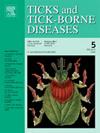Prevalence and diversity of Borrelia spp. in questing ticks from urban green spaces in Lithuania
IF 3.4
2区 医学
Q2 INFECTIOUS DISEASES
引用次数: 0
Abstract
Lithuania is a highly endemic area for Lyme borreliosis (LB), and Ixodes ricinus, the primary vector of Borrelia burgdorferi sensu lato (s.l.) in Europe, is widespread throughout the country. While previous studies conducted in Lithuania have examined the prevalence of B. burgdorferi s.l. in natural habitats, comprehensive data on the distribution of ticks and their infection with tick-borne pathogens in urban areas remain largely unknown. This study aimed to assess the risk of LB by analyzing tick abundance and the prevalence of Borrelia spp. in ticks collected from urban green spaces across ten Lithuanian counties. A total of 3628 ticks were collected, comprising two species: I. ricinus (n = 3599) and Dermacentor reticulatus (n = 29). Ticks were found in 43 out of 52 investigated locations. Molecular analyses detected B. burgdorferi s.l. in 22.89 % of I. ricinus and 3.45 % of D. reticulatus specimens, while Borrelia miyamotoi was found in 3.97 % of I. ricinus and 3.45 % of D. reticulatus. Five species from B. burgdorferi s.l. complex were identified: B. afzelii, B. garinii, B. burgdorferi s.s., B. lusitaniae, and B. valaisiana. Co-infections with different Borrelia spp. were observed in 0.72 % of I. ricinus ticks. Borrelia-infected ticks were detected at 38 of 43 locations (88.37 %), with the prevalence of infection ranging from 3.70 % to 41.53 %. These findings indicate that urban green spaces in Lithuania provide suitable habitats for ticks, with varying risks of human-tick contact and tick-borne infections, underscoring the potential public health risk of LB in Lithuanian cities. Further evaluation of tick distribution and the prevalence of Borrelia spp. is necessary to monitor how climate change and urbanization affect pathogen circulation and infection risk.
立陶宛城市绿地蜱虫中疏螺旋体的流行和多样性
立陶宛是莱姆博氏疏螺旋体(LB)的高度流行地区,欧洲感氏伯氏疏螺旋体(s.l)的主要媒介蓖麻伊蚊(Ixodes ricinus)在全国广泛传播。虽然以前在立陶宛进行的研究已经检查了自然栖息地伯氏疏螺旋体s.l.的流行情况,但关于蜱的分布及其在城市地区感染蜱传病原体的综合数据在很大程度上仍然未知。本研究旨在通过分析立陶宛10个县城市绿地收集的蜱的丰度和伯氏疏螺旋体的流行程度,评估LB的风险。共采集蜱3628只,其中蓖麻蜱3599只,网状皮蜱29只。在52个调查地点中,有43个发现了蜱虫。在22.89%的蓖麻蠓和3.45%的网纹蠓中检出伯氏疏螺旋体,在3.97%的蓖麻蠓和3.45%的网纹蠓中检出宫氏疏螺旋体。从伯氏疏螺旋体复合体中鉴定出5种:阿氏疏螺旋体、加里尼疏螺旋体、伯氏疏螺旋体、卢西塔尼亚疏螺旋体和瓦莱西亚疏螺旋体。0.72%的蓖麻蜱同时感染不同伯氏疏螺旋体。43个地点中有38个(88.37%)检出感染伯氏螺旋体蜱,感染率为3.70% ~ 41.53%。这些发现表明,立陶宛的城市绿地为蜱虫提供了适宜的栖息地,人类与蜱虫接触和蜱虫传播感染的风险各不相同,强调了立陶宛城市LB的潜在公共卫生风险。有必要进一步评估蜱的分布和疏螺旋体的流行情况,以监测气候变化和城市化对病原体循环和感染风险的影响。
本文章由计算机程序翻译,如有差异,请以英文原文为准。
求助全文
约1分钟内获得全文
求助全文
来源期刊

Ticks and Tick-borne Diseases
INFECTIOUS DISEASES-MICROBIOLOGY
CiteScore
6.90
自引率
12.50%
发文量
185
审稿时长
6-12 weeks
期刊介绍:
Ticks and Tick-borne Diseases is an international, peer-reviewed scientific journal. It publishes original research papers, short communications, state-of-the-art mini-reviews, letters to the editor, clinical-case studies, announcements of pertinent international meetings, and editorials.
The journal covers a broad spectrum and brings together various disciplines, for example, zoology, microbiology, molecular biology, genetics, mathematical modelling, veterinary and human medicine. Multidisciplinary approaches and the use of conventional and novel methods/methodologies (in the field and in the laboratory) are crucial for deeper understanding of the natural processes and human behaviour/activities that result in human or animal diseases and in economic effects of ticks and tick-borne pathogens. Such understanding is essential for management of tick populations and tick-borne diseases in an effective and environmentally acceptable manner.
 求助内容:
求助内容: 应助结果提醒方式:
应助结果提醒方式:


